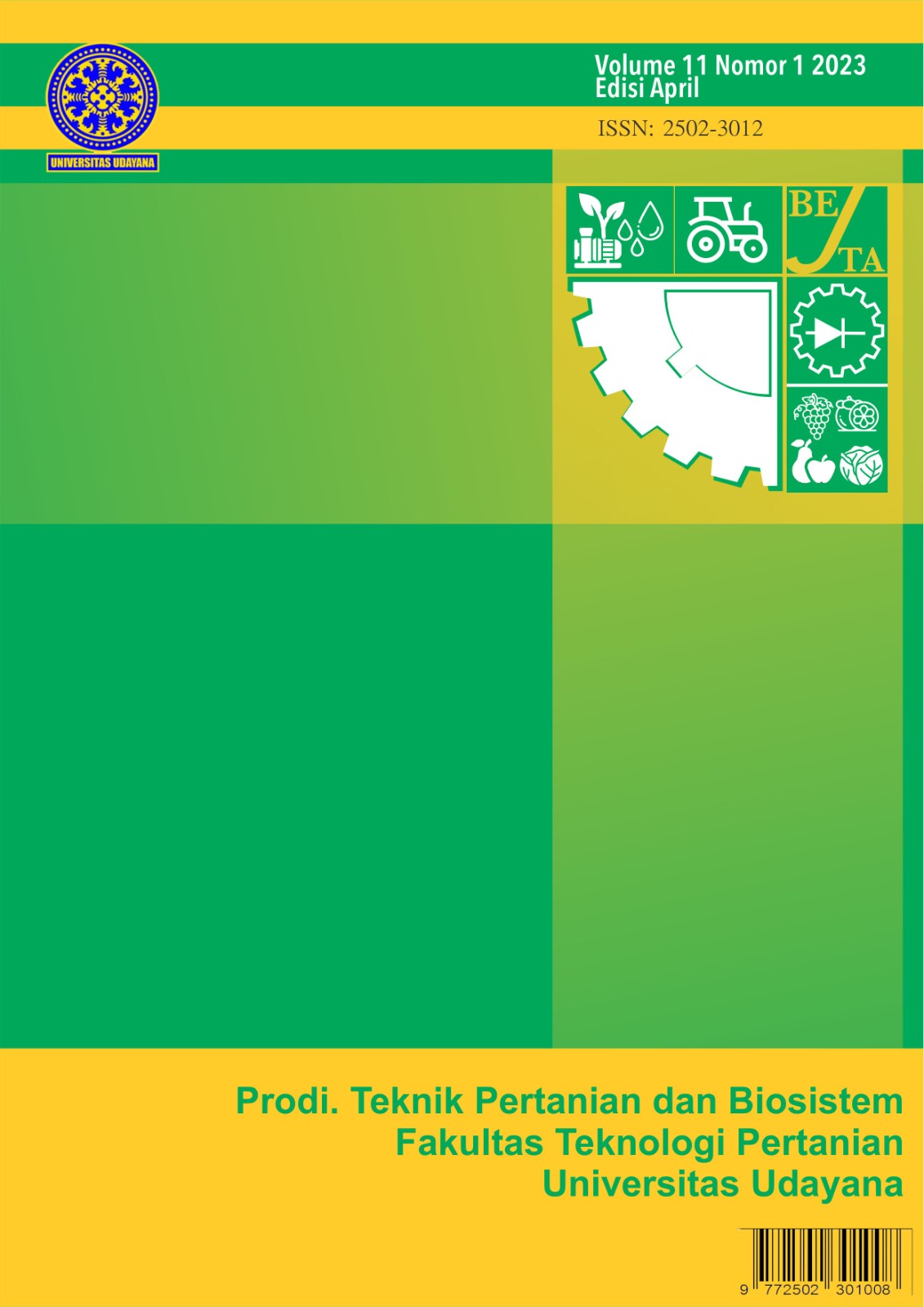Effect of Light Emitting Diode (LED) Red Blue on the Production of Pakcoy (Brassica rapa L.)
Abstract
Abstract
The horticulture sub-sector is one of the fundamental sectors for body nutrition. Pakcoy (Brassica Rapa L.) has good nutritional content, high economic value, and is widely found in Indonesia. Sunlight plays an important role in the photosynthesis process of plants so that the right spectrum and intensity of light will have an impact on the characteristics and yields of plants. Therefore, artificial light is used to help agricultural activities. This study aims to determine the effect of light intensity on the production of Pakcoy plants. The research method was an experimental method that used Red (640-650 nm) and Blue LED lights (465-470 nm) with the light intensity of 1000 lux, 1500 lux, 2000 lux, 2500 lux, and 3000 lux, and applied for 12 hours. The analytical method used is a completely randomized design analysis. The results showed that the production of Pakcoy is significantly affected by red-blue LED light intensity, and the results showed that pakcoy biomass which uses a light intensity of 3000 lux to get the best results from other treatments, with the average value of the crown and root sizes of 0.6222 units(gram) and 0.0424 units(gram), respectively. The most effective and efficient light intensity for optimal production of Pakcoy was 3000 lux. Where 3000 lux produces the highest production. In conclusion, the greater the intensity of light given, the greater the production effect obtained by the Pakcoy.
Downloads
References
Badan Pusat Statistika. (2020). Statistik Hortikultura 2019 (5204003rd ed.). 05120.2002.
Chen, L., Zhang, K., Gong, X., Wang, H., GAO, Y., WANG, X., ZENG, Z., & HU, Y. (2020). Effects of different LEDs light spectrum on the growth, leaf anatomy, and chloroplast ultrastructure of potato plantlets in vitro and minituber production after transplanting in the greenhouse. Journal of Integrative Agriculture, 19(1), 108–119.
Gupta, D. S., & Agarwal, A. (2017). Light emitting diodes for agriculture: Smart lighting. In Light Emitting Diodes for Agriculture: Smart Lighting.
Ferita, I., Akhir, N., Fauza, H., & Syofyanti, E. (2009). Pengaruh Intensitas Cahaya Terhadap Pertumbuhan Bibit Gambir (Uncaria gambir Roxb). Jurnal Jerami, 2(2), 249–254.
Gautama, D. P. Y., Wijaya, I. M. A. S., & Widia, I. W. (2018). Musik Gamelan Bali Meningkatkan Pertumbuhan dan Produktivitas Tanaman Sawi Pakcoy (Brassica rafa L.). Jurnal BETA (Biosistem Dan Teknik Pertanian), 6(2), 73. https://doi.org/10.24843/jbeta.2018.v06.i02.p03
Hakim, R. M. A., Hendrawan, Y., & Lutfi, M. (2015). Rancang Bangun Plant Factory untuk Pertumbuhan Tanaman Sawi Hijau (Brassica Rapa var. Parachinensis) dengan Menggunakan Led (Light Emitting Diode) Merah dan Biru. Jurnal Keteknikan Pertanian Tropis Dan Biosistem, 3(3), 382–390.
Kosyk, O. I., Khomenko, I. M., Batsmanova, L. M., & Taran, N. Y. (2017). Phenylalanine ammonia-lyase activity and anthocyanin content in different varieties of lettuce under the cadmium influence. The Ukrainian Biochemical Journal, 89,№ 2, 85–91.
Lindawati, Y., Triyono, S., & Suhandy, D. (2015). Neon Terhadap Pertumbuhan Dan Hasil Tanaman Pakcoy ( Brassica Rapa L .) Dengan Hidroponik Sistem Sumbu ( Wick System ). Jurnal Teknik Pertanian Lampung, 4(3), 191–200.
Muhyidin, R. M. R., Prawiranegara, B. M. P., & Bahtiar, A. (2019). Pengaruh Spektrum dan Intensitas Cahaya Buatan (Artifical Lighting) pada LED Chips on Board (COB) Terhadap Karakteristik Tanaman Selada keriting (Lactuca sativa L.). Jurnal Teknik Tanah Dan Air, 1(1).
Mutryarny, E., & Lidar, S. (2018). Respon tanaman pakcoy (Brassica rapa L) akibat pemberian zat pengatur tumbuh hormonik. Jurnal Ilmiah Pertanian, 14(2), 29–34.
Naznin, M. T., & Lefsrud, M. (2017). An overview of LED lighting and spectral quality on plant photosynthesis. Light Emitting Diodes for Agriculture, 101–111.
Pantilu, L. I., Mantiri, F. R., Nio, S. A., & Pandiangan, D. (2012). Respons Morfologi dan Anatomi Kecambah Kacang Kedelai (Glycine max (L.) Merill) terhadap Intensitas Cahaya yang Berbeda (Morphological and Anatomical Responses of The Soybean (Glycine max (L.) Merill) Sprouts to The Different Light Intensity). Jurnal Bios Logos, 2(2).
Restiani, A. R., Triyono, S., Tusi, A., & Zahab, R. (2015). Pengaruh jenis lampu terhadap pertumbuhan dan hasil produksi tanaman selada (Lactuca sativa L.) dalam sistem hidroponik indoor. Jurnal Teknik Pertanian Fakultas Pertanian Universitas Lampung, 4(3), 219–226.
Sigmarawan, G. T., Wijaya, I. M. A. S., & Budisanjaya, I. P. G. (2019). Efek Kombinasi Musik Gamelan Gong Kebyar dan Cahaya LED (Light Emitting Diode) Terhadap Pertumbuhan dan Produktivitas Sawi Pakcoy (Brassica rapa L.). Jurnal BETA (Biosistem Dan Teknik Pertanian), 8(1), 1. https://ojs.unud.ac.id/index.php/beta/article/view/47704
Wiguna, I. K. W., Wijaya, I., & Nada, I. M. (2017). Pertumbuhan tanaman krisan (Crhysantemum) dengan berbagai penambahan warna cahaya lampu LED selama 30 hari pada fase vegetatif. BETA (Biosistem Dan Tek. Pertanian), 3(2), 1–11.












 Jurnal BETA (Biosistem dan Teknik Pertanian)
Jurnal BETA (Biosistem dan Teknik Pertanian)


